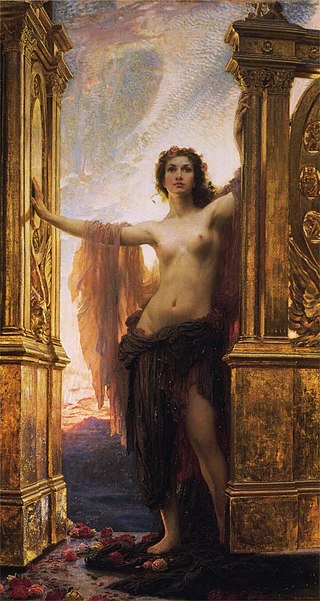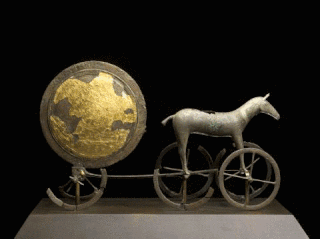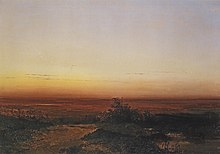
The Baltic languages are a branch of the Indo-European language family spoken natively or as a second language by a population of about 6.5–7.0 million people mainly in areas extending east and southeast of the Baltic Sea in Europe. Together with the Slavic languages, they form the Balto-Slavic branch of the Indo-European family.

In ancient Greek mythology and religion, Eos is the goddess and personification of the dawn, who rose each morning from her home at the edge of the river Oceanus to deliver light and disperse the night. In Greek tradition and poetry, she is characterized as a goddess with a great sexual appetite, who took numerous human lovers for her own satisfaction and bore them several children. Like her Roman counterpart Aurora and Rigvedic Ushas, Eos continues the name of an earlier Indo-European dawn goddess, Hausos. Eos, or her earlier Proto-Indo-European (PIE) ancestor, also shares several elements with the love goddess Aphrodite, perhaps signifying Eos's influence on her or otherwise a common origin for the two goddesses. In surviving tradition, Aphrodite is the culprit behind Eos' numerous love affairs, having cursed the goddess with insatiable lust for mortal men.
Zorya is a figure in Slavic folklore, a feminine personification of dawn, possibly goddess. Depending on tradition, she may appear as a singular entity, or two or three sisters at once. Although Zorya is etymologically unrelated to the Proto-Indo-European goddess of the dawn *H₂éwsōs, she shares most of her characteristics. She is often depicted as the sister of the Sun, the Moon, and Danica, the Morning Star with which she is sometimes identified. She lives in the Palace of the Sun, opens the gate for him in the morning so that he can set off on a journey through the sky, guards his white horses, she is also described as a virgin. In the Eastern Slavic tradition of zagovory she represents the supreme power that a practitioner appeals to.

Proto-Indo-European mythology is the body of myths and deities associated with the Proto-Indo-Europeans, speakers of the hypothesized Proto-Indo-European language. Although the mythological motifs are not directly attested – since Proto-Indo-European speakers lived in preliterate societies – scholars of comparative mythology have reconstructed details from inherited similarities in mythological concepts found in Indo-European languages, based on the assumption that parts of the Proto-Indo-Europeans' original belief systems survived in the daughter traditions.

Aurōra is the Latin word for dawn, and the goddess of dawn in Roman mythology and Latin poetry. Like Greek Eos and Rigvedic Ushas, Aurōra continues the name of an earlier Indo-European dawn goddess, Hausos.
Lithuanian mythology is the mythology of Lithuanian polytheism, the religion of pre-Christian Lithuanians. Like other Indo-Europeans, ancient Lithuanians maintained a polytheistic mythology and religious structure. In pre-Christian Lithuania, mythology was a part of polytheistic religion; after Christianisation mythology survived mostly in folklore, customs and festive rituals. Lithuanian mythology is very close to the mythology of other Baltic nations such as Prussians and Latvians, and is considered a part of Baltic mythology.
Aušrinė is a feminine deity of the morning star (Venus) in the Lithuanian mythology. She is the antipode to "Vakarinė", the evening star.

Saulė is a solar goddess, the common Baltic solar deity in the Lithuanian and Latvian mythologies. The noun Saulė/Saule in the Lithuanian and Latvian languages is also the conventional name for the Sun and originates from the Proto-Baltic name *Sauliā > *Saulē.

Ushas is a Vedic goddess of dawn in Hinduism. She repeatedly appears in the Rigvedic hymns, states David Kinsley, where she is "consistently identified with dawn, revealing herself with the daily coming of light to the world, driving away oppressive darkness, chasing away evil demons, rousing all life, setting all things in motion, sending everyone off to do their duties". She is the life of all living creatures, the impeller of action and breath, the foe of chaos and confusion, the auspicious arouser of cosmic and moral order called the Ṛta in Hinduism.

The Balto-Slavic languages form a branch of the Indo-European family of languages, traditionally comprising the Baltic and Slavic languages. Baltic and Slavic languages share several linguistic traits not found in any other Indo-European branch, which points to a period of common development and origin.

Perkūnas was the common Baltic god of thunder, and the second most important deity in the Baltic pantheon after Dievas. In both Lithuanian and Latvian mythology, he is documented as the god of sky, thunder, lightning, storms, rain, fire, war, law, order, fertility, mountains, and oak trees.

*Dyḗus, also *Dyḗus ph₂tḗr, is the reconstructed name of the daylight-sky god in Proto-Indo-European mythology. *Dyēus was conceived as a divine personification of the bright sky of the day and the seat of the gods, the *deywṓs. Associated with the vast diurnal sky and with the fertile rains, *Dyēus was often paired with *Dʰéǵʰōm, the Earth Mother, in a relationship of union and contrast.

Prende or Premte is the dawn goddess, goddess of love, beauty, fertility, health and protector of women, in the Albanian pagan mythology. She is also called Afër-dita, an Albanian phrase meaning "near day", "the day is near", or "dawn", in association with the cult of the planet Venus, the morning and evening star. She is referred to as Zoja Prenne or Zoja e Bukuris. Her sacred day is Friday, named in Albanian after her: e premte, premtja. She reflects features belonging to the original Indo-European dawn goddess. A remarkable reflection associated with the Indo-European dawn goddess is the Albanian tradition according to which Prende is the daughter of the sky god – Zojz.
Baltic mythology is the body of mythology of the Baltic peoples stemming from Baltic paganism and continuing after Christianization and into Baltic folklore.
Proto-Baltic is the unattested, reconstructed ancestral proto-language of all Baltic languages. It is not attested in writing, but has been partly reconstructed through the comparative method by gathering the collected data on attested Baltic and other Indo-European languages. It represents the common Baltic speech that approximately was spoken between the 3rd millennium BC and ca. 5th century BC, after which it began dividing into West and East Baltic languages. Proto-Baltic is thought to have been a fusional language and is associated with the Corded Ware and Trzciniec cultures.
*Perkʷūnos is the reconstructed name of the weather god in Proto-Indo-European mythology. The deity was connected with fructifying rains, and his name was probably invoked in times of drought. In a widespread Indo-European myth, the thunder-deity fights a multi-headed water-serpent during an epic battle in order to release torrents of water that had previously been pent up. The name of his weapon, *mel-d-(n)-, which denoted both "lightning" and "hammer", can be reconstructed from the attested traditions.

The Divine Twins are youthful horsemen, either gods or demigods, who serve as rescuers and healers in Proto-Indo-European mythology.
A dawn god or goddess is a deity in a polytheistic religious tradition who is in some sense associated with the dawn. These deities show some relation with the morning, the beginning of the day, and, in some cases, become syncretized with similar solar deities.
The Dieva Dēli are heavenly beings depicted as the sons of the sky-god Dievs in Latvian mythology.
*Seh₂ul and *Meh₁not are the reconstructed Proto-Indo-European Sun deity and Moon deity respectively. *Seh₂ul is reconstructed based on the solar deities of the attested Indo-European mythologies, although its gender is disputed, since there are deities of both genders. Likewise, *Meh₁not- is reconstructed based on the lunar deities of the daughter languages, but they differ in regards to their gender.












